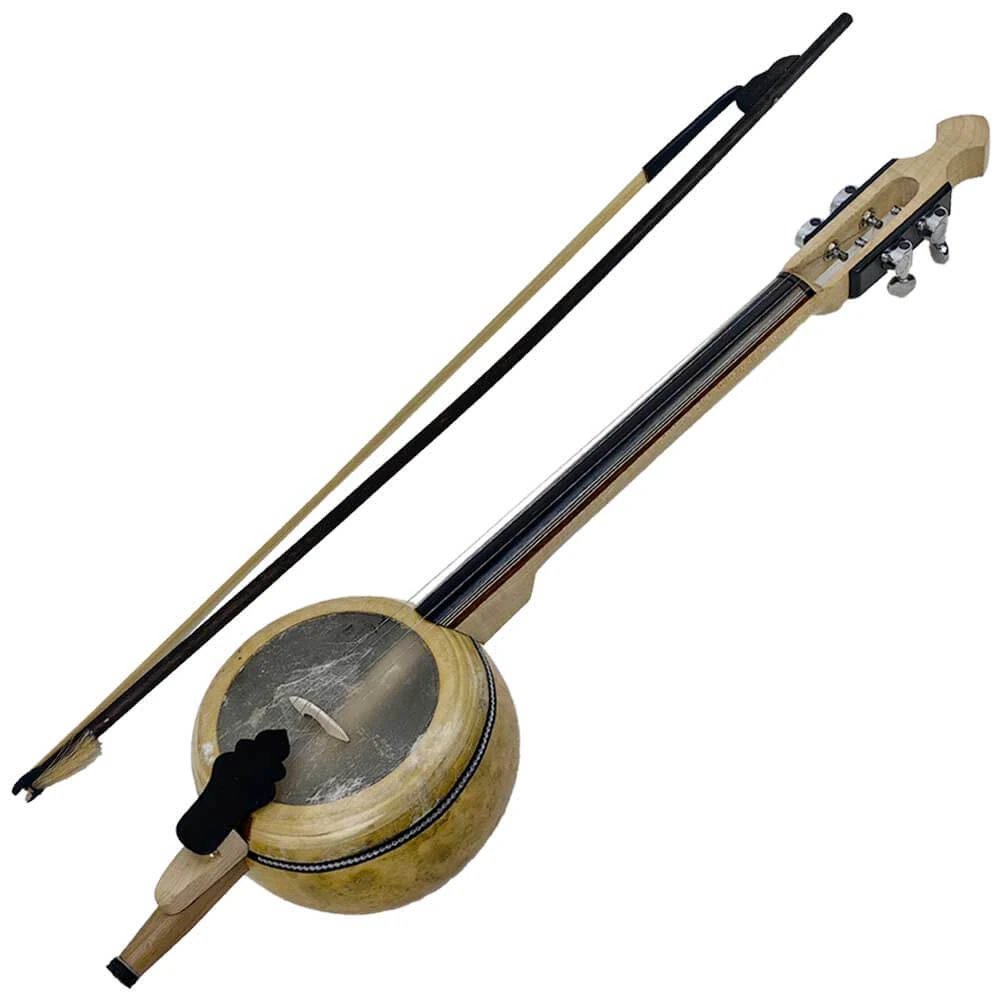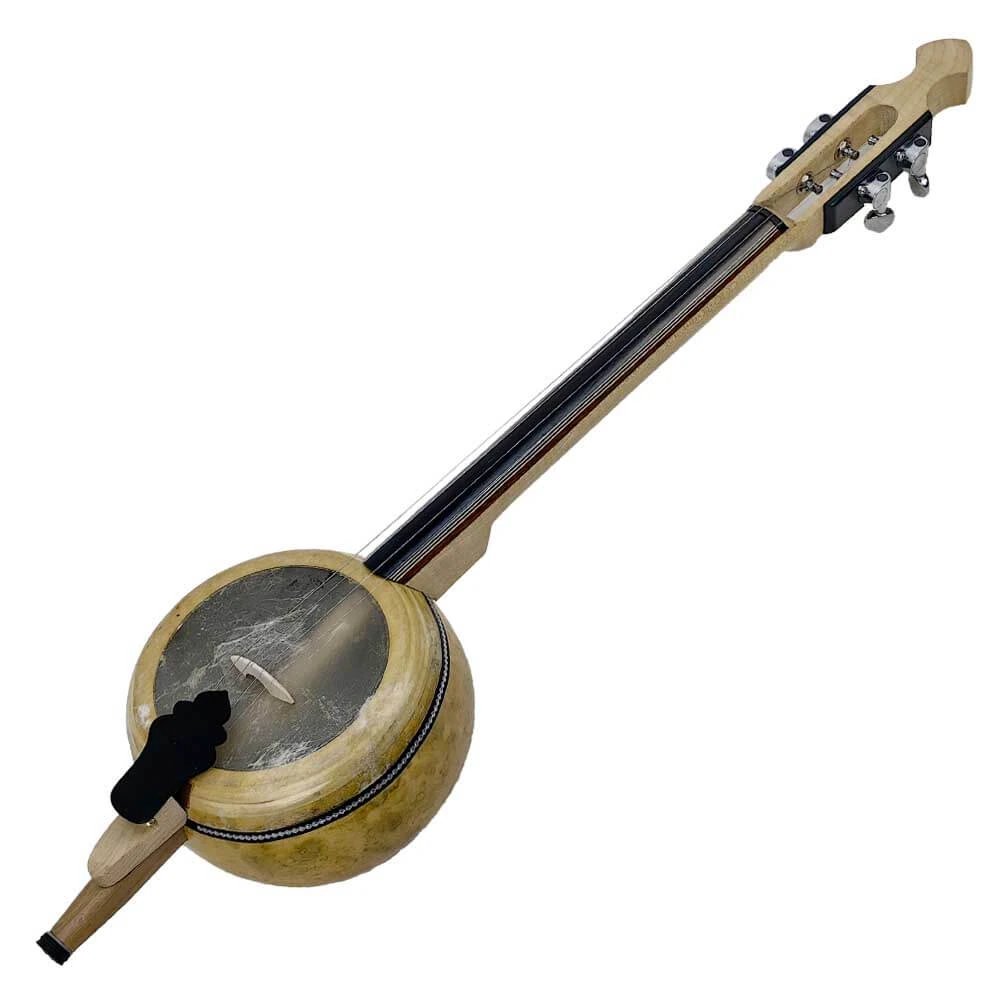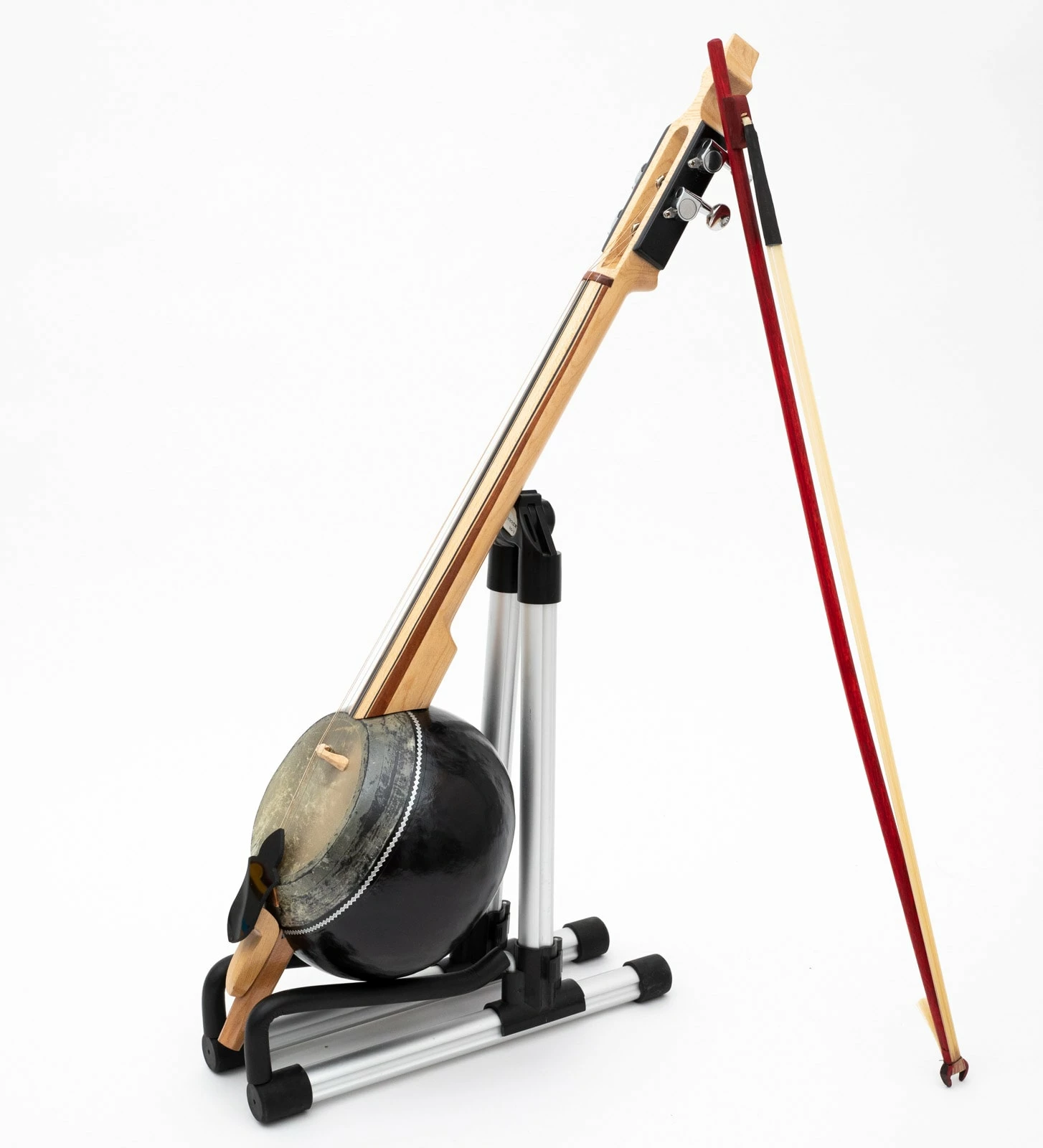Kabak kemane
Bowed Instruments
Asia
Between 1001 and 1900 AD
Video
The Kabak Kemane is a traditional bowed string instrument originating from Turkey and commonly played in regions influenced by Turkish and Central Asian musical traditions. This instrument holds significant cultural and historical value and is often associated with folk and classical music styles. Known for its deep, expressive sound, the Kabak Kemane is crafted from natural materials and played using a unique bowing technique that allows for intricate tonal variations.
Historical Background
The Kabak Kemane has a long history that traces back to Central Asian and Anatolian cultures. It is considered a descendant of the ancient rebab, a stringed instrument that spread throughout the Middle East, North Africa, and parts of Europe. As it evolved, the Kabak Kemane became a key instrument in Turkish folk music, particularly in the Aegean and Mediterranean regions. Over time, it has been adapted into various musical traditions and ensembles, gaining popularity beyond its original cultural boundaries.
Construction and Materials
The Kabak Kemane is traditionally made from a gourd (kabak), which forms the resonator body of the instrument. The gourd is hollowed out and covered with a thin membrane, usually made of fish skin or animal hide, which acts as the soundboard. The instrument has a wooden neck, often crafted from hardwoods such as mulberry or walnut, and features tuning pegs similar to those of a violin. The strings, originally made from gut, have been replaced in modern versions with metal or synthetic materials. The bow is traditionally strung with horsehair, though modern versions sometimes use synthetic alternatives. The instrument is played in an upright position, typically resting on the knee or held against the chest.
Types and Variations
Although the standard Kabak Kemane remains widely used, there are regional variations that differ in shape, size, and materials. Some variations use different types of gourds, while others incorporate modern elements such as adjustable bridges or additional strings for a wider tonal range. Additionally, electric versions of the instrument have emerged, allowing for amplified performances in contemporary music settings.
Characteristics and Sound
The Kabak Kemane is known for its rich, warm, and resonant sound. Due to its bowed nature and the use of a flexible bowing technique, it produces a highly expressive tone with dynamic pitch control. The instrument’s ability to perform glissando and microtonal variations makes it well-suited for traditional Turkish and Middle Eastern maqam music, which relies on nuanced melodic structures. The resonance of the gourd body enhances the depth of sound, while the fish-skin soundboard contributes to the unique timbre. Because of these characteristics, the Kabak Kemane can be both melancholic and uplifting, depending on the style of playing and the choice of repertoire.
Playing Techniques
The Kabak Kemane is played with a bow, and the player employs a combination of wrist and finger movements to achieve vibrato and microtonal inflections. Unlike the violin, which relies on pressing the strings against a fingerboard, the Kabak Kemane is played by lightly touching the strings without a solid fingerboard, allowing for greater pitch flexibility. Techniques such as tremolo, harmonics, and dynamic bowing contribute to the expressive quality of the instrument. Players also use different bowing pressures and speeds to achieve variations in tone and articulation. Some advanced performers integrate percussive effects by tapping the instrument’s body or using bowing techniques that mimic vocal ornamentation.
Applications in Music
The Kabak Kemane is widely used in Turkish folk music, classical Ottoman music, and various regional styles. It is commonly found in ensembles featuring instruments like the bağlama, kanun, and ney. In contemporary settings, it has been incorporated into world music, fusion genres, and experimental compositions. Its ability to produce microtonal melodies makes it particularly valuable for maqam-based music traditions, where intricate melodic progressions are essential. Some modern musicians have adapted the instrument for jazz, ambient, and electronic music, expanding its role beyond traditional applications.
Traditional Folk Music – The Kabak Kemane is widely used in Turkish folk music, particularly in the Aegean, Mediterranean, and Central Anatolian regions.
Classical Turkish Music – It appears in Ottoman classical music ensembles, adding depth and emotional expression.
Sufi and Devotional Music – Frequently played in Sufi gatherings, enhancing the spiritual atmosphere with its haunting sound.
Contemporary and Fusion Music – Used in modern compositions, blending with jazz, rock, and world music genres.
Film and Theater Scores – Employed in movie soundtracks and stage performances to evoke cultural and historical themes.
Educational Purposes – Taught in conservatories and music institutions to preserve traditional Turkish bowed instruments.
Improvisational Music – Commonly used in taksim (solo improvisation) performances, showcasing its expressive capabilities.
Accompaniment for Dance – Supports traditional dances such as Zeybek and Horon, enhancing their rhythmic and melodic feel.
Cultural Significance
As a cultural symbol, the Kabak Kemane represents the deep musical heritage of Turkey and surrounding regions. It has been used in storytelling, ritualistic performances, and traditional celebrations. The instrument’s sound is often associated with emotional expression, making it a staple in melancholic and reflective compositions.
In educational settings, the Kabak Kemane is taught in music conservatories and folk music programs, preserving its tradition while allowing for innovation. Efforts have been made to document and revive interest in the instrument through academic research, recordings, and international collaborations.
Maintenance and Care
Proper maintenance of the Kabak Kemane is crucial to preserving its sound quality and longevity. Key maintenance practices include:
- Regularly tightening and loosening the bow hair to prevent overstretching.
- Keeping the instrument in a dry, moderate climate to prevent the gourd from cracking or the membrane from deteriorating.
- Cleaning the strings and bow hair to remove rosin buildup.
- Replacing worn-out strings and periodically checking the bridge for alignment.
- Because of its delicate construction, the Kabak Kemane should be stored in a padded case when not in use to avoid accidental damage.
Advantages and Disadvantages
The Kabak Kemane offers several advantages that make it a unique and expressive instrument. Its rich, resonant tone and ability to produce microtonal nuances make it ideal for traditional Turkish and Middle Eastern music, as well as for fusion genres. Its compact size and lightweight construction enhance portability, making it easy for musicians to carry and play in various settings. Additionally, its bowed playing technique allows for deep emotional expression, similar to the violin or rebab, making it an excellent choice for conveying melancholic and soulful melodies. The Kabak Kemane is also relatively inexpensive compared to other bowed string instruments, making it more accessible to aspiring musicians. Furthermore, the instrument’s versatility enables it to be used in solo performances, ensembles, and even modern experimental music.
Despite its advantages, the Kabak Kemane has some disadvantages. One of the biggest challenges is the difficulty of mastering the instrument due to its fretless fingerboard, which requires precise finger placement to achieve correct intonation. Additionally, the instrument’s sound projection is relatively soft compared to other bowed instruments, limiting its use in larger ensembles without amplification. The traditional use of gut or horsehair strings and bow hairs also requires regular maintenance and replacement, adding to the upkeep efforts. Moreover, because the Kabak Kemane is not as widely played as the violin or cello, finding skilled teachers and learning resources can be challenging, especially outside Turkey and surrounding regions. Finally, the delicate nature of its resonating body, often made from a gourd, requires careful handling to prevent damage, making it less durable than some other string instruments.
It is a remarkable instrument with a rich history and a distinct voice in the world of music. Its construction, playing techniques, and cultural significance make it a vital component of Turkish and Middle Eastern musical traditions. While it presents challenges in terms of learning curve and maintenance, its expressive capabilities and unique tonal qualities continue to attract musicians and audiences alike. As interest in world music grows, the Kabak Kemane is poised to find new avenues of appreciation and innovation in the global music scene.
FAQ
What materials are used to construct the Kabak Kemane?
The Kabak Kemane is traditionally made from a hollowed-out gourd for the body, with a wooden or skin-covered soundboard. The neck is typically crafted from hardwood, and the strings are made of horsehair or synthetic materials. The bow is also strung with horsehair.
How is the Kabak Kemane played?
It is played with a bow, similar to a violin, but held vertically. The musician uses a combination of bowing and finger pressure on the strings, often employing vibrato and microtonal slides. The instrument is known for its expressive and melancholic sound.
What are the advantages of the Kabak Kemane?
The Kabak Kemane is highly expressive, allowing for microtonal nuances ideal for traditional Turkish and Middle Eastern music. Its lightweight and compact design make it portable. Additionally, its simple construction allows for easy maintenance and affordability compared to other bowed instruments.
 Links
Links
References
Other Instrument
Categories




















